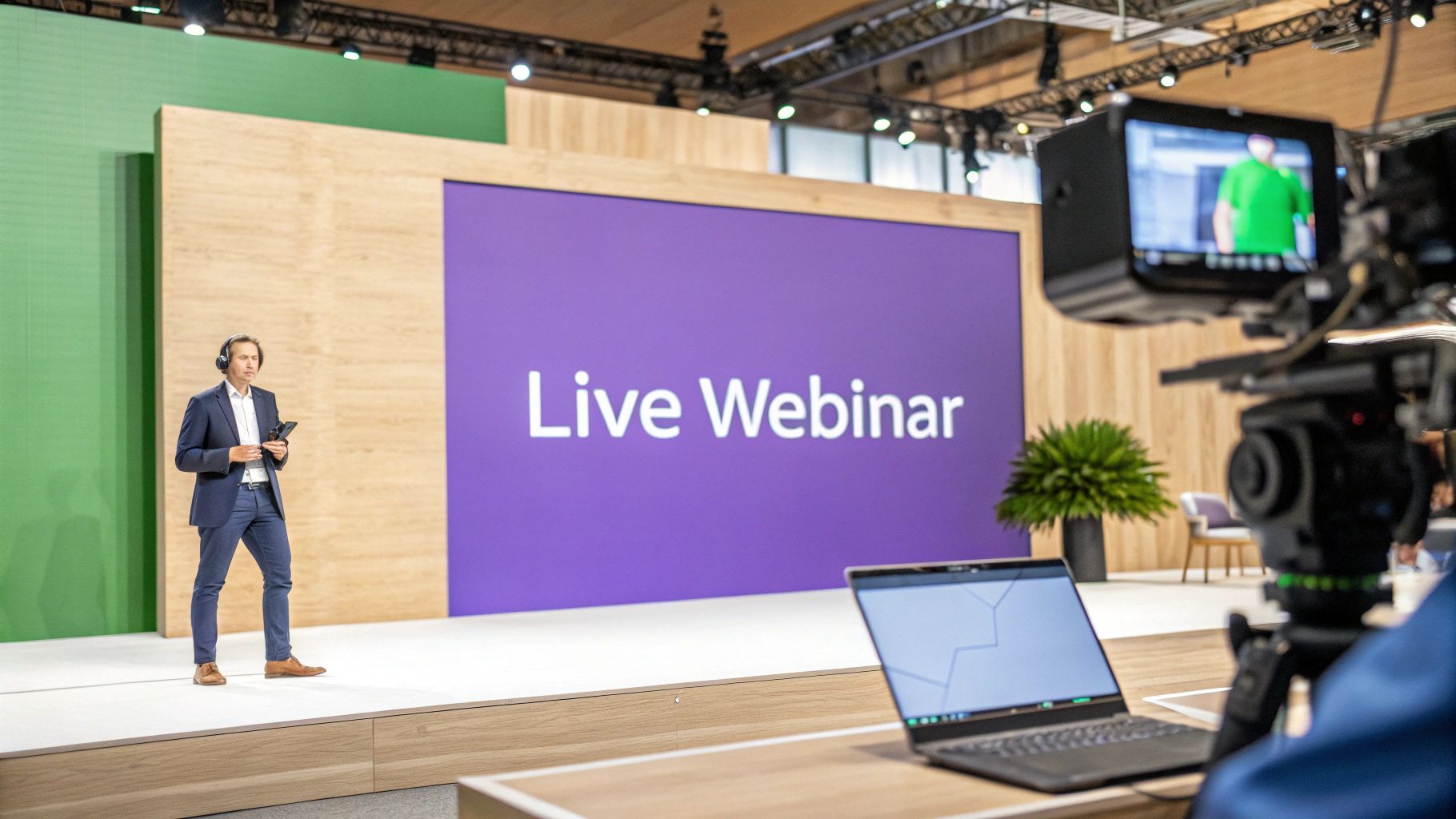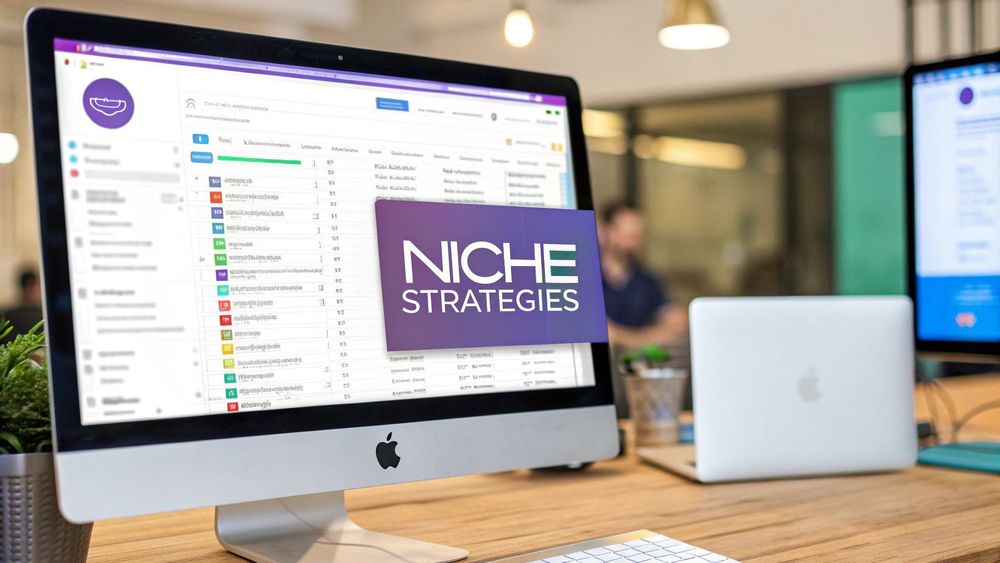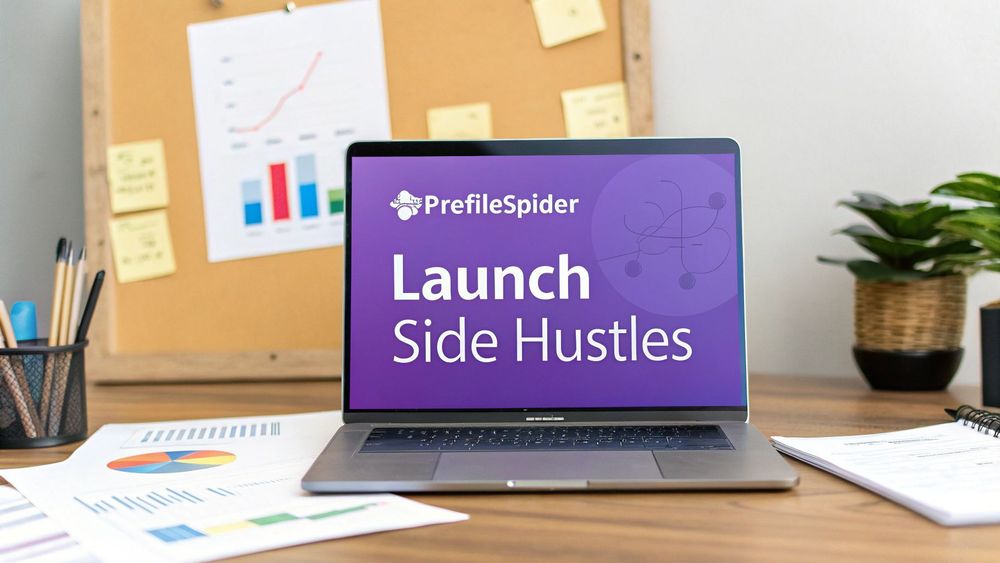Growing an email list is a top priority, but the old playbook of generic pop-ups and broad appeals is failing. The modern business landscape demands precision. A generic list attracts lukewarm leads, tanks engagement rates, and wastes marketing efforts. In contrast, a hyper-targeted list built on specific needs and interests becomes your most valuable asset. It's a direct line to pre-qualified prospects who are eager to hear from you because you've already proven you understand their specific challenges.
This guide moves beyond the basics, exploring seven advanced niche list-building strategies designed for recruiters, sales teams, and marketers who need to connect with the right people, right now. To truly move beyond generic growth, it's essential to understand how to effectively nail your target audience on LinkedIn, setting the foundation for all subsequent niche strategies. Once you have that clarity, the tactics outlined here will empower you to build a high-quality, engaged audience that drives real business results.
We'll break down the 'how' for each strategy, providing actionable steps you can implement immediately. More importantly, we'll show how a no-code tool like ProfileSpider transforms these strategies from time-consuming manual processes into a simple, one-click workflow, allowing you to focus on building relationships instead of just building lists.
1. Targeted Lead Magnets & Hyper-Relevant Content Upgrades
This foundational strategy moves beyond generic, one-size-fits-all downloads. Instead, it focuses on creating highly specific, valuable resources that solve an immediate and pressing problem for a narrow segment of your audience. The key to making this one of the most effective niche list-building strategies is relevance. A recruiter is far more likely to subscribe for a "Technical Sourcing Checklist for Python Developers" than a broad "Guide to Recruiting."

The real power of this method is unlocked with content upgrades. These are lead magnets embedded directly within relevant blog posts or articles. For example, a blog post about challenges in sales prospecting could offer a "Top 10 Cold Email Outreach Templates" download. This ensures the leads you capture are not just passively interested but are actively seeking the exact solution you provide at that very moment. While this method requires creating valuable content, the business value is clear: a list of highly engaged, pre-qualified leads.
How ProfileSpider Simplifies This
A powerful content upgrade requires deep audience understanding. The traditional way is guesswork. The modern way is data-driven. Use ProfileSpider to extract profiles from LinkedIn groups or forums where your target audience discusses their pain points. Analyzing their job titles, companies, and shared content reveals the exact language and challenges they face, allowing you to create lead magnets that are guaranteed to resonate. Instead of guessing what a "Sales Development Representative" needs, you can build a list of them, analyze their profiles, and create the perfect resource.
Actionable Steps for Implementation:
- Identify Top-Performing Content: Use your website analytics to find your most popular blog posts. These articles already have proven traffic and engagement, making them the perfect candidates for a content upgrade.
- Create a Hyper-Relevant Resource: Develop a simple, high-value asset that complements the existing article. This doesn't need to be a 50-page ebook; checklists, templates, cheat sheets, or short video tutorials work exceptionally well.
- Craft a Compelling Call-to-Action (CTA): Make the value proposition crystal clear. Use headlines like, "Download the Free [Resource Name] to Implement This Strategy in 5 Minutes." Keep the opt-in form brief, asking only for essential information like a name and email.
- Ensure Instant Delivery: Configure your email marketing system to deliver the promised resource immediately upon signup. This builds trust and provides instant gratification, encouraging subscribers to stay engaged.
2. Webinar & Online Event Funnels
This strategy positions you as an authority by combining high-value education with lead generation. Instead of just offering a downloadable asset, you provide a live or automated training event focused on a specific pain point relevant to your niche. Attendees register with their email addresses, creating a list of highly engaged and interested prospects who have already invested their time to learn from you. This is one of the most powerful niche list-building strategies for service providers, consultants, and SaaS companies.

The funnel approach is what makes this so effective. It involves promoting the event, capturing registrants, reminding them to attend, delivering valuable content during the webinar, and following up with attendees and non-attendees afterward. A well-executed webinar doesn't just build a list; it builds trust and primes the audience for a future offer. The business value lies in creating a highly qualified audience segment ready for a sales conversation.
How ProfileSpider Simplifies This
Promoting a niche webinar requires targeted outreach. Manually searching for potential attendees or expert guests on LinkedIn is slow and tedious. With ProfileSpider, you can visit a relevant LinkedIn event page, a competitor’s follower list, or a professional group and extract hundreds of profiles in a single click. This creates an instant, pre-qualified outreach list. You can then export this data to your CRM and invite these specific individuals to your event, ensuring a room full of your ideal attendees.
Actionable Steps for Implementation:
- Choose a Hyper-Specific Topic: Identify a single, urgent problem your niche audience faces. A webinar titled "Sourcing Passive Tech Talent on GitHub" will attract higher-quality leads for a recruiter than a generic "Recruiting 101" event.
- Create a High-Converting Registration Page: Keep the page simple and benefit-focused. Use a compelling headline, bullet points outlining what attendees will learn, and a clear call-to-action. Only ask for essential information like name and email to maximize sign-ups.
- Promote Across Relevant Channels: Share your webinar on social media, in relevant online communities, to your existing email list, and through targeted ads. Start promotion at least two to three weeks in advance to build momentum.
- Set Up an Automated Reminder Sequence: A significant portion of registrants will not attend live without reminders. Configure automated emails to go out 24 hours before, one hour before, and right as the webinar starts.
3. Niche Community & Forum Engagement
This strategy shifts the focus from broadcasting a message to fostering a conversation. Instead of solely pushing content out, you actively participate in dedicated spaces where your niche audience connects, shares, and learns—like private Slack channels, Facebook Groups, or specialized forums. By adding value and becoming a recognized expert, you can naturally direct members to your resources and email list.
This approach transforms list building from a transactional exchange (email for a PDF) into a relational one. The goal is to become a trusted member of the "watering hole" for your specific niche. The business value comes from building deep trust and authority, which makes converting community members into leads or customers nearly effortless.
How ProfileSpider Simplifies This
Identifying key influencers and potential leads within a bustling online community is a major challenge. The traditional method is to scroll endlessly and manually copy-paste profiles. ProfileSpider streamlines this into a one-click process. Visit any online community page, whether it's a forum, a social media group, or a list of event attendees. With a single click, ProfileSpider's AI extracts all visible profiles—names, titles, companies, and social links—into an organized list. You can then tag them as "community influencers" or "potential prospects" for targeted, relationship-building outreach.
Actionable Steps for Implementation:
- Choose Your Platform: Select a platform where your niche audience is already comfortable. Tech-focused audiences may prefer Slack or Discord, while B2C or creative niches might thrive in a Facebook Group. Start small and focus on one primary platform.
- Establish Credibility Through Value: Before promoting anything, become a valuable contributor. Answer questions, share insights, and engage in discussions genuinely. Your goal is to build a reputation as an expert, not a spammer.
- Provide Exclusive Resources: Once you have credibility, you can share links to your lead magnets or webinar registration pages when relevant. Frame it as helping the community, e.g., "I created a checklist for this exact problem, you can grab it here."
- Facilitate, Don't Dominate: Your role is to be a helpful member. Encourage discussions and highlight valuable contributions from others. The community's primary value comes from member-to-member interaction.
4. Strategic Partnerships & Co-Marketing
This strategy leverages the simple but powerful principle of audience sharing. Instead of building your list from scratch, you collaborate with non-competing businesses or influencers who serve a similar niche audience. By tapping into their established trust and reach, you can introduce your brand to a pre-qualified group of potential subscribers.
These collaborations can take many forms, from co-hosted webinars and joint research reports to guest podcast appearances. For example, a recruiting software (ATS) company might partner with a popular recruiting influencer for a joint webinar on "How to Build a Talent Pipeline in 2025." This is a win-win: the business gets warm leads, and the influencer provides value to their audience.
How ProfileSpider Simplifies This
Finding the right partners is the most time-consuming part of this strategy. The old way involves manual searches and endless spreadsheets. ProfileSpider makes it easy. Go to a conference website and extract a list of speakers. Visit a competitor’s social media page and extract their most engaged followers. Browse a relevant online publication and extract the authors. In minutes, you can build a highly targeted list of potential partners—complete with names, titles, and companies. This turns hours of manual research into a one-click action, allowing you to focus on outreach and building relationships.
Actionable Steps for Implementation:
- Identify Potential Partners: Brainstorm complementary businesses or influencers in your niche. Look for those with a similar audience size and strong engagement.
- Craft a Compelling Value Proposition: Don't just ask, "Can I promote to your list?" Instead, frame your outreach around mutual benefit. Propose a co-created resource or a joint webinar that makes them look good to their audience.
- Start with a Small, Low-Risk Collaboration: Begin with a simple exchange, like a guest blog post swap or a shared social media promotion. This builds trust before you commit to a larger campaign.
- Create Dedicated Landing Pages: For each partnership, use a unique landing page that acknowledges the partner's audience, such as "A Special Offer for the [Partner's Brand] Community." This simple step can dramatically increase conversion rates.
5. Quiz & Assessment Funnels
This interactive strategy transforms passive content consumption into an active, engaging experience. Instead of a static download, you provide a quiz or assessment that promises personalized results. Visitors are naturally curious to learn more about themselves or their business, making this one of the most compelling niche list-building strategies available. The user enters their email to receive their custom results, providing you with a lead and valuable segmentation data simultaneously.

The key is that the quiz provides genuine value, making the email exchange feel like a small price for a personalized consultation. For a sales team, a "Sales Skill Assessment" quiz can segment leads by experience level. For a recruiter, a "Career Path Finder" quiz can help segment candidates by interest.
Why This Approach Excels for Niche Lists
The genius of a quiz funnel is its powerful, built-in segmentation. The answers a person provides reveal their specific pain points and goals. This allows for incredibly targeted follow-up email sequences that speak directly to the subscriber's unique situation, dramatically increasing engagement and conversion rates. The business value is a list that is not just captured, but automatically organized for hyper-personalized marketing.
Actionable Steps for Implementation:
- Define a Clear Goal: Determine what you want to learn about your audience. Are you trying to identify their biggest challenge, their budget, or their specific interests? Design your quiz questions around this central objective.
- Create an Engaging Quiz: Keep the quiz short and focused, ideally between 5-15 questions. Use a conversational tone. To implement this, you can explore the best free survey tools, many of which offer quiz-building functionalities.
- Gate the Results, Not the Quiz: Allow users to take the entire quiz without interruption. The opt-in form should only appear at the very end when they are most invested and eager to see their personalized results.
- Deliver Valuable, Personalized Results: The results page or email should provide genuine insight and actionable advice based on the user's answers. This builds trust and positions you as an expert. Connect each result type to a tailored follow-up email sequence.
6. Podcast & Audio Content Strategy
This strategy leverages one of the most intimate and trust-building mediums available today: audio. Launching a niche podcast allows you to build a deep, personal connection with your audience. Unlike written content, audio accompanies listeners during their commute or workout, creating a consistent presence in their lives. This recurring engagement provides powerful opportunities to grow a highly dedicated email list.
The core principle is to deliver exceptional, targeted audio content that attracts a loyal listenership. Within each episode, you can seamlessly mention lead magnets or exclusive resources that listeners can access by joining your email list. This turns passive listeners into active, engaged subscribers who feel a genuine connection to your brand.
How ProfileSpider Simplifies This
A great podcast relies on great guests. Finding and researching experts in your niche is a manual, time-intensive process. ProfileSpider accelerates this. Identify a list of top industry blogs, conference speaker pages, or LinkedIn articles. With one click, ProfileSpider extracts the authors' or speakers' profiles. You can instantly create a list of potential guests, complete with their professional details. This no-code approach allows you to build a high-caliber guest list in minutes, not days, ensuring your content remains valuable and authoritative.
Actionable Steps for Implementation:
- Define Your Niche and Format: Identify a specific, underserved topic within your industry. Decide on a format (interviews, solo shows) and a consistent publishing schedule to build listener habits.
- Create an Irresistible Opt-In: Develop a high-value resource directly related to your podcast's theme. Mention this lead magnet consistently in every episode, directing listeners to a simple, memorable URL.
- Use Episode-Specific Upgrades: For each episode, create a unique landing page with show notes and an episode-specific "content upgrade," like a guest's presentation slides or a checklist based on the topic discussed.
- Leverage Guest Audiences: When you interview guests, you gain exposure to their audience. Make it easy for them to share the episode and encourage their listeners to check out your show and resources.
7. SEO-Driven Content & Organic Search Strategy
This strategy shifts from direct outreach to inbound attraction by creating comprehensive, SEO-optimized content that ranks for niche keywords. Instead of actively seeking out leads, you build an asset that draws them to you through organic search. When a potential lead searches for a solution on Google, they find your detailed blog post and subscribe to your email list to get even more value.
This method transforms your website into a perpetual lead-generation machine. The business value is a sustainable, low-cost stream of high-intent leads who are actively looking for the solutions you provide. It’s a long-term play that builds a powerful, compounding asset for your business.
How ProfileSpider Simplifies This
Top-tier SEO content often features quotes and insights from industry experts to build authority (a tactic known as an "expert roundup"). Manually finding these experts, collecting their details, and reaching out is a huge time sink. With ProfileSpider, you can go to any article listing "Top 50 Sales Leaders" or "Top 100 Recruiters to Follow," and extract all 100 profiles with a single click. This gives you an instant outreach list to solicit quotes, build relationships, and earn valuable backlinks, significantly speeding up the creation of authoritative, SEO-driven content.
Actionable Steps for Implementation:
- Identify High-Intent Keywords: Use SEO tools to find long-tail keywords your niche audience is searching for. Focus on phrases that signal a problem (e.g., "how to find software developer candidates" for recruiters).
- Create Pillar Content: Develop a comprehensive, in-depth resource that thoroughly covers the topic. This should be the best piece of content available on that subject. Structure it with clear headings, images, and data.
- Optimize for On-Page SEO: Ensure your title tags, meta descriptions, and headers are optimized for your target keyword to maximize click-through rates from search engines.
- Embed Strategic CTAs: Place clear calls-to-action within your content. Offer content upgrades like checklists or templates. Don't just wait until the end; place one after the introduction and another mid-way through the article.
7-Strategy Niche List-Building Comparison
| Strategy | Complexity & Process 🔄 | Resources & Cost ⚡ | Expected Outcomes 📊 | Ideal Use Cases 💡 | Key Advantages ⭐ |
|---|---|---|---|---|---|
| Lead Magnets & Content Upgrades | Moderate — upfront content creation, simple delivery flows 🔄 | Low–Moderate — content creation time, landing page/form tools ⚡ | High conversion (10–50%+ when targeted); qualified leads 📊 | Blog-driven traffic, top-performing posts, early list growth 💡 | Cost-effective, builds trust, measurable conversions ⭐ |
| Webinar & Online Event Funnels | High — live/evergreen setup, multi-step funnels, technical coordination 🔄 | High — platform fees, production, promotion, staffing ⚡ | Captures warm, high-engagement leads; potential for higher AOV 📊 | Product launches, demo/education-heavy offers, high-ticket sales 💡 | Authority-building, direct interaction, repurposable content ⭐ |
| Niche Community & Forum Engagement | Moderate–High — ongoing moderation and culture management 🔄 | Moderate — community managers, moderation tools, time investment ⚡ | Highly loyal, engaged audience; slower scale but lower churn 📊 | Retention, product feedback, advocacy programs, launch audiences 💡 | Deep engagement, organic referrals, customer insights ⭐ |
| Strategic Partnerships & Co‑Marketing | Moderate — partner vetting, alignment, joint planning 🔄 | Low–Moderate — shared costs; time for negotiations and coordination ⚡ | Rapid audience expansion with targeted, warm traffic 📊 | Entering new niches, co-launches, audience swaps, amplifying reach 💡 | Fast scale, shared credibility, cost-efficient growth ⭐ |
| Quiz & Assessment Funnels | Moderate — quiz design, segmentation logic, gating flow 🔄 | Moderate — quiz platform, copy/design, analytics ⚡ | Very high engagement/completion; strong segmentation for follow-up 📊 | Audience segmentation, social-driven lead gen, personalized funnels 💡 | Viral shareability, automated personalization, rich data ⭐ |
| Podcast & Audio Content Strategy | Moderate — production cadence and guest coordination 🔄 | Moderate–High — equipment, editing, hosting, promotion ⚡ | Deep parasocial relationships; slow-to-moderate list growth 📊 | Authority building, networking through guests, long-term brand growth 💡 | High listener loyalty, repeat touchpoints, guest-driven audiences ⭐ |
| SEO‑Driven Content & Organic Search Strategy | High — research, technical SEO, content clusters, ongoing updates 🔄 | Moderate–High — sustained content production, SEO tools, backlinks ⚡ | High-quality intent-driven leads; compounding long-term traffic 📊 | Evergreen acquisition, high-commercial-intent topics, scalable content systems 💡 | Sustainable traffic, low ad spend long-term, authority building ⭐ |
From Strategy to Execution: Building Your Niche List Today
Throughout this guide, we've moved beyond generic advice and dived deep into the specific, high-impact approaches that define successful audience growth. We have explored a diverse set of niche list-building strategies, from the direct value exchange of Lead Magnets to the community-driven engagement of Niche Forums and the collaborative power of Strategic Partnerships.
The common thread is a fundamental shift in mindset. True list-building isn't about casting the widest net; it's about crafting the perfect lure for a specific audience. It’s about trading mass appeal for magnetic relevance. Quizzes, webinars, and SEO-driven content are sophisticated systems for attracting, qualifying, and capturing the attention of your ideal customer, candidate, or partner. By focusing on value first, you build more than just a list of emails; you cultivate an asset and a community of engaged advocates.
The Bridge Between Strategy and Action
Having a powerful strategy is essential, but it remains theoretical without efficient execution. The biggest bottleneck for most recruiters, sales reps, and marketers isn't a lack of ideas, but the overwhelming manual labor required to build targeted lists for outreach.
- For Strategic Partnerships: You need to manually find and list potential co-marketing partners, influencers, or podcast hosts.
- For Community Engagement: You must manually identify key moderators, active members, and industry leaders within niche forums or social groups.
- For Webinar Funnels: You have to manually research potential expert guests or identify high-value attendees for post-event follow-up.
This manual data entry—copying and pasting names, titles, and company details from dozens of websites—is not a scalable activity. It's tedious, error-prone, and a drain on your most valuable resource: time. This is precisely where ProfileSpider transforms a great plan into a tangible result.
Your Actionable Next Steps with ProfileSpider
To translate the strategies in this article into immediate action, your next step is to eliminate the manual bottleneck. ProfileSpider is the modern, no-code alternative designed to be the operational engine behind your niche list-building strategies.
- Revisit Your Chosen Strategy: Select one or two strategies from this article that best align with your business goals. For example, if you chose "Niche Community Engagement," your first task is to identify the top 3-5 online communities where your ideal audience gathers.
- Identify Key Individuals: Browse those communities, LinkedIn Groups, or industry forums. Look for the most active contributors, the moderators, or individuals asking questions that your product or service can solve.
- Execute One-Click AI Profile Extraction: Instead of opening a spreadsheet and starting the manual grind, simply click the ProfileSpider browser extension. Its AI instantly extracts all visible professional profiles from the webpage into a structured list.
- Organize and Tag: Within ProfileSpider, create a new list titled "Community Outreach [Name of Community]" and add relevant tags like
moderator,power-user, orpotential_partner. This segmentation is crucial for personalized outreach. - Enrich and Export: If you need contact details, click “Enrich” to have ProfileSpider find missing emails and phone numbers. Once your list is complete, export it as a CSV, Excel, or JSON file, ready to be imported into your CRM or email marketing platform for a highly targeted outreach sequence.
By adopting this simple, one-click workflow, you close the gap between knowing what to do and actually doing it. You transform a process that once took hours of painstaking research into a task that takes mere minutes. This is how you gain the strategic velocity needed to consistently build the high-quality, niche lists that will drive your business forward.




